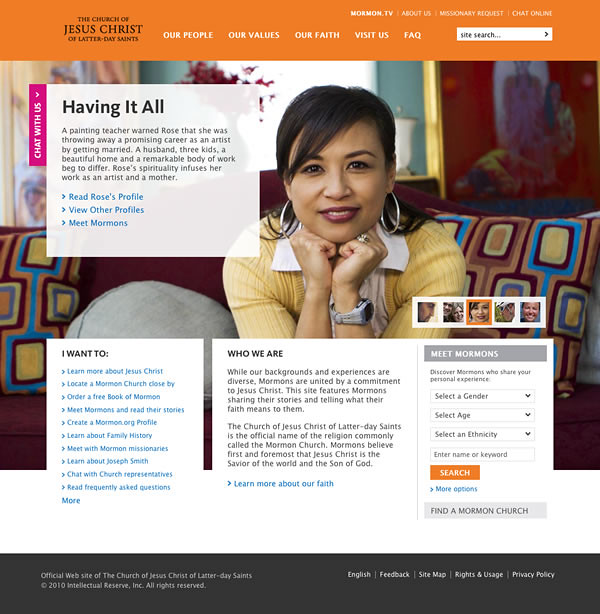case study
New Mormon.org
In the next couple of days, The Church of Jesus Christ of Latter-day Saints will be releasing a new version of its missionary site, Mormon.org. This new site is meant to introduce the church to friends and family and to the world.
The new Mormon.org has been years in the making as I will share what has been our process and our experience. We hope that this post could benefit designers visiting our site. Honestly, this is motivation for me to record what has been done to make such a site.
1. The Research
Research began a couple of years ago in order for us, as a Church, to understand who our audiences are. We know that the Gospel of Jesus Christ is for all but we also understood the limitations of our reach online and in media (TV, radio, print). The results from the research included some good and some bad perceptions of Mormons. Many studies were done that I cannot enumerate but it was, for sure, comprehensive. The creative team was not part of the research, as we were not part of the project yet until about 10 months ago, which at that point we learned of the research findings.
2. The Discovery Phase
The discovery phase started with a core creative team that included two designers and a front-end developer from our department (ICS), a creative director, a designer, and a researcher from Sapient, whom we partnered with. Two more researchers from our research division assisted us during this phase. A project manager and program manager were also available. And our product manager also spent a lot of time with the creative team.
The first thing we did as a team was to have fun. Because we were not always in the same location, we spent a lot of time with each other and played a lot (of foosball) when we were. Looking back, this really helped break down barriers that sometimes hybrid teams have.

During this phase, our work was divided into three parts: research, wireframes, and mood boards. We wanted to do additional research on visitors of Mormon.org so an online questionnaire was developed and then put on the site for a few days. The wireframes were created based on the research we’ve found, the current site, and from our own brainstorming exercises. Lots of sketches and ideas were proposed. The ball was rolling.

During this time, several mood boards were put together and gave us different flavors to look at. Several became a few, then a couple.
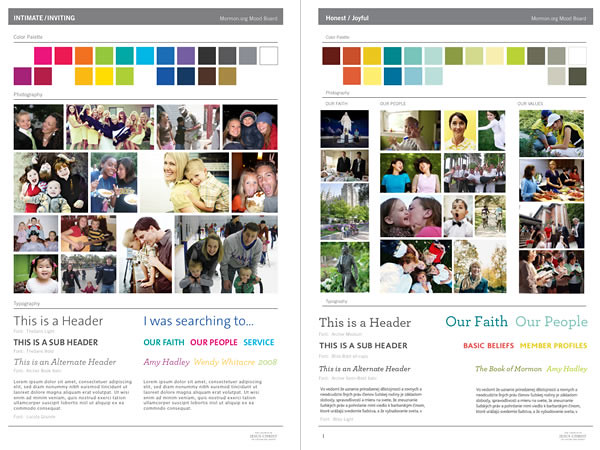
We also started to form the information architecture based on the content that was being discussed. Our first pass? People, Basic Beliefs, and Visit. Then it became: People, Faith, Values, and Visit. Our last iteration before testing was: Our People, Our Values, Our Faith, and Visit Us. We wanted to be clear that these are our perspectives and did not want to impose on other people’s beliefs.
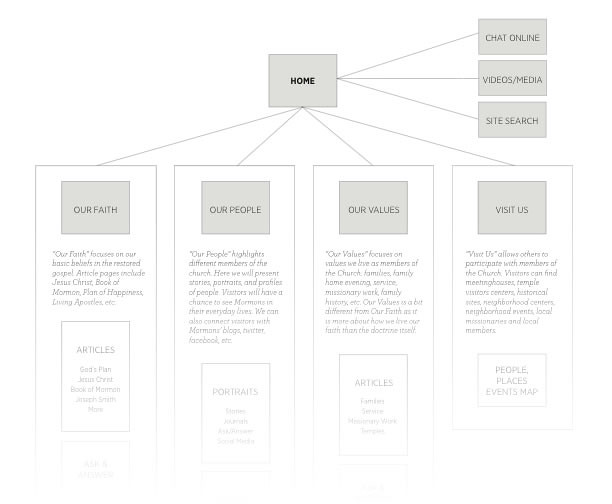
Additional wireframes were created as we grouped all ideas. Now using our mood boards, we created comps of main sections for review with the stakeholders. Feedback was immediate. We had a good idea of where we needed to go “visually”.
Prototyping in HTML/CSS/JS (with a little bit of PHP) was now in top gear. We had three weeks before the prototype testing. Preparations were being made throughout this phase as we were ready to go out and test the prototype.
3. Prototype Testing
Two locations within the U.S. were selected for our prototype testing: Los Angeles and Atlanta. For our prototype testing, we wanted to know more than anything if what we’re proposing would help improve perceptions of people about Mormons. We took our participants through several scenarios to help them explore the site. (There was a part of the test where we left the participant on their own for a few minutes and watched them click around the site. That was revealing.) We tested the visual design, tone of voice, information architecture, and interaction.
What we learned is that people did not know very much about the Mormons nor that we are a very diverse church. We also learned that people wanted to know what we believe in and, unfortunately, what we’ve prototyped was not enough. They wanted more. They also wanted to know some answers to frequently asked questions about the Mormons but didn’t know where to go. At the end of the session, each participant was asked if their perceptions of Mormons have changed after reviewing the prototype and most, if not all, said yes, on the positive.
Some of our assumptions were confirmed but there was work still to do. We came home energized.
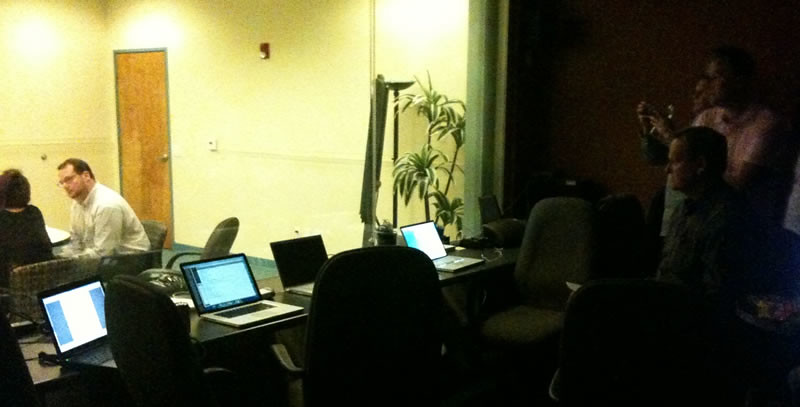
4. The Discovery Phase Part II
There was a clear direction on the visual design from the team on how we should proceed. People in LA and Atlanta had a different idea of what Mormons look like. What we showed them changed their minds. I think it helped to show what Mormons look like six out of the seven days of the week. That has helped set the visual tone of the site.
More comps and more prototyping were finished. We added FAQ to the main navigation.

5. The Writing
All throughout the discovery and prototype testing, the creative team either wrote the copy or copied stuff from existing resources. If we were to do it over again, we would have hired professional writers.
So we did. We looked at several writers and we decided on a woman and a man to help write for the site. We knew we needed Mormon writers because they understand our beliefs but we also wanted the outsiders’ perspective.
The creative team provided a content style guide that focused on voice and tone, grammar, and avoiding Mormon slang. We said: “The voice and tone should mimic a relaxed conversation with a friend about the gospel in a safe and comfortable place such as your home.” We wanted it to be conversational.
We also provided the writers outlines of each page. These outlines came from the existing site and other materials or talks from Church leaders. The writers got started. Much of the new site was written by these awesome writers that we have.
6. The Detail Design Phase
As the pages came back from the writers, the design team started putting it all together in detail. At this point, we picked up another designer to help keep up with the schedule. Each page was meticulously designed to help present the message well. The design team also arranged for photo shoots with our own Audio Visual department. Other photos came from our own media library or stock photo websites. Our front-end team (there were two now) took these detail designs and finished the pages.
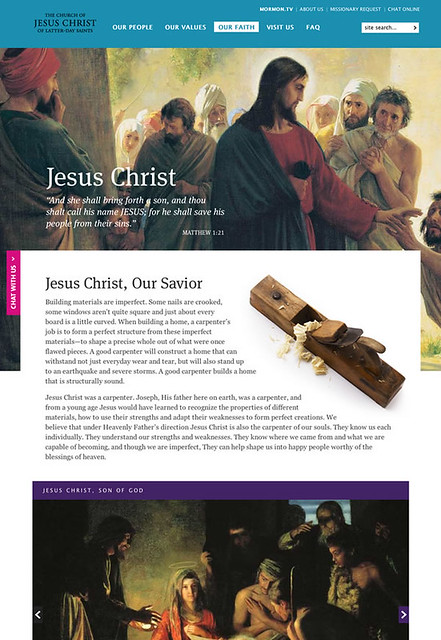
We also finalized our style guide to help coordinate the many designers, developers and producers involved in the project. Here’s the style guide:
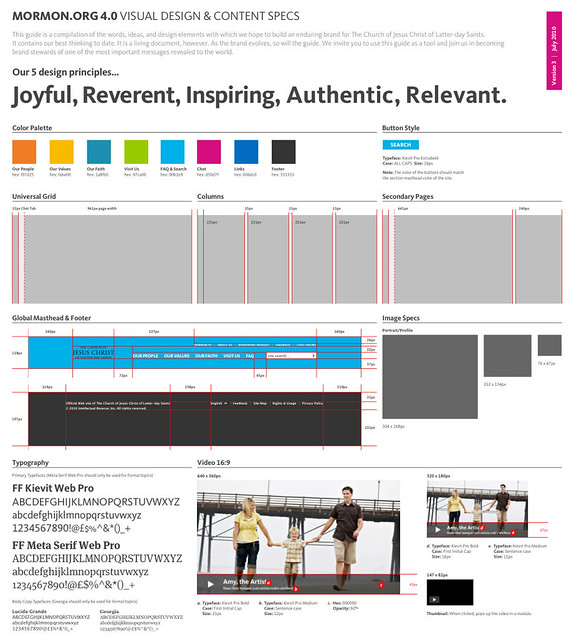
7. The Video Production Phase
Right on the heels of detail design was the video production. Several teams went out and started producing videos for the site and media advertising. These included interviews of Mormons and their stories. You will find these videos under “Our People” and also throughout the site. They are powerful.
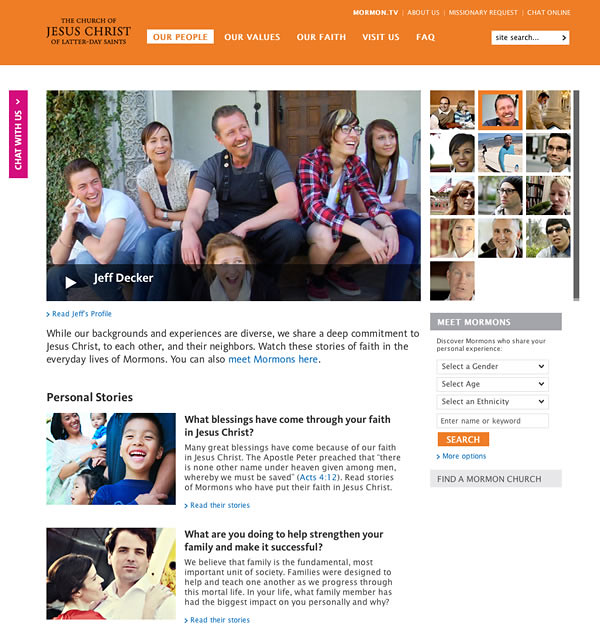
8. The Development Phase
The development phase started at the beginning of this year. We have six developers, three quality assurance engineers, and two infrastructure support engineers. Development kicked off as we now have pages ready. Our development team is solid and always ready to help.
9. User-Generated Content
One of the first major development pieces was our user-generated content. A big part of the new site is Mormons sharing their stories and answering frequently asked questions. About three months ago, we started inviting members of the Church to create their profiles and helping with user-generated content on the site. We wanted to launch with at least 1,000 profiles. We have since surpassed that.
There has been a lot of great excitement on this ability to share your stories and testimony. I will definitely be sharing mine with my friends and family who may not know what my beliefs are.
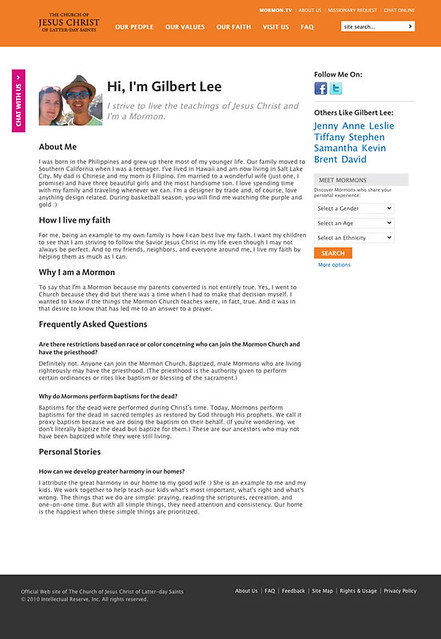
10. The Final Stage
Now that all this research, discovery, testing, writing, detail design, video production, development, and user-generated content has come together, we have been spending a lot of time crossing t’s and dotting i’s. I don’t think I ever anticipated how time consuming it is to make it all “finished”. But, of course, the site will never be finished. However, in a couple of days, all this work from the last couple of years will be available to the world.

11. Conclusion
In all of my five years of working for the LDS Church, I have yet to find a project that is exactly the same as the last one. And as much as we want to “streamline process” or “develop a resource model”, it will never be the same for each project. But here’s a short list of what I have learned from this project:
Good Planning. Good planning allowed for different groups as diverse as this project had to see what is needed and when. A good plan will focus on actual work produced and not administration milestones. Short meetings were also set everyday to report status and progress of assignments.
Strong Teams. Whether it was the creative team or the development team, developing strong relationships helped us at those times when we were in a bind or “crunch mode”. The idea of roles went away. We just focused on getting the job done. Lots of team members did “unusual” things throughout our project.
Enough Resources. Having enough resources helped with this project. There were times when we needed additional creative help. There was still resistance to this but we prevailed and was able to add to the team in the middle of the project. Sometimes you just have to ask.
Hiding From Scrutiny. Because of the significance of the site, there were many outside of our project who wanted to know everything that we were doing. Our product manager was smart enough to know that that would slow us down and not help us. So we were hiding from scrutiny most of the time during this project and only reported to the necessary people. Those who simply wanted to know just had to wait. At the end, it was for the best of the project.
12. An Invitation
Our main mission as a Church is to help all to “come unto Christ”. As imperfect as we, Mormons, are, we are striving to follow Him in our own lives. Our hope is that the new Mormon.org will help others see who we are and what we sincerely believe in. We hope it will improve people’s perceptions of Mormons.
If you are a member of the LDS Church, we invite you to create a profile on New.Mormon.org. Think of your profile as a personal invitation to your family and friends who may know you’re a Mormon but not understand what you believe in. It’s a non-confrontational invitation. Once they read your profile, they are then able to explore the rest of the site.
13. The Credits
Every magazine, book, or movie always give credit to those involved in its creation, so why not a website? Here’s the Mormon.org Team:
Product Management
Scott Swofford, Ron Wilson
Design Team
Bryan Bishop, Gilbert Lee, Brent Stewart, Matt Carlson, Paul Mayne
Front-end Team
Craig Hobson, David Max Hicken
Writers
Gail Newbold, Jake Wilhelmsen
Program Management
Ted Marshall, Lauren
Development Team
Colin Lewis, Kip Armstrong, David Steiner, Jake Trent, Bryson Spencer, Steve Olson
Quality Assurance Team
Greg Patterson, Steve Hatch, John Hauptman
Infrastructure Support
Dean Householder, Ron Ulloa
Film Team
Tara White, Eric Morgan, Christian Lambert, Justin Jones, and many other directors and producers
Research Team
Chris Korintus, Sam Sturgeon, Linda Charney
Interns
David Gary “Digger” Godfrey, Carl Canlas
Support
Tom Jackman, Brandon Jackson, and many other students from BYU
Bonneville Communications
Brandon Burton, Eric Morgan, VondaKay Warshaw
Many thanks to others from the Missionary Department, ICS Department, AV Department, and Bonneville Communications who helped make this happen!

